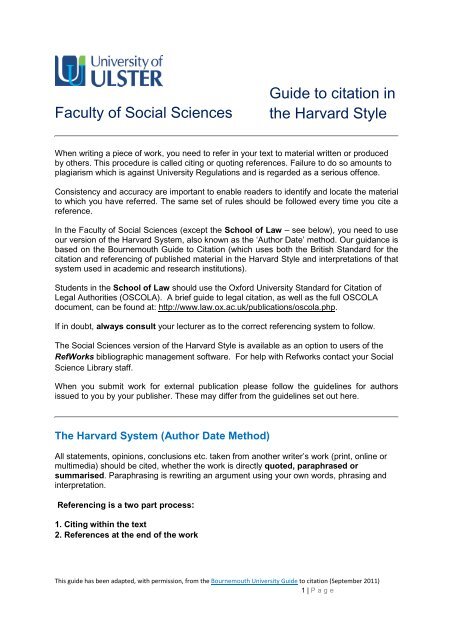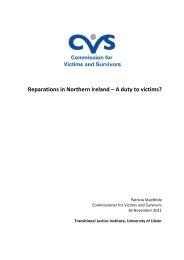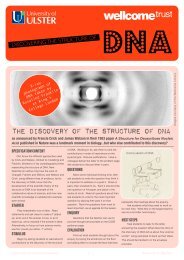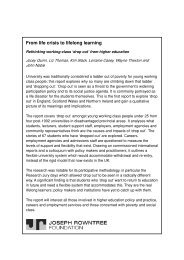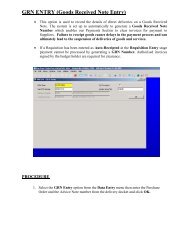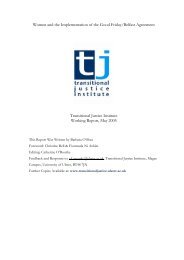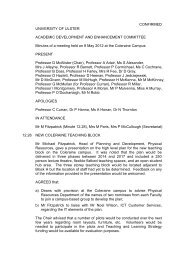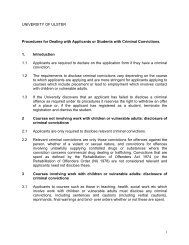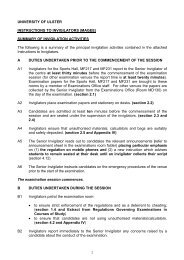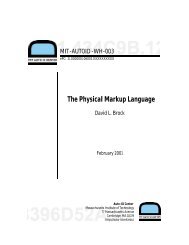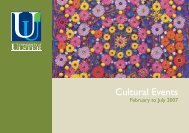Guide to Citation in the Harvard Style - University of Ulster Library
Guide to Citation in the Harvard Style - University of Ulster Library
Guide to Citation in the Harvard Style - University of Ulster Library
Create successful ePaper yourself
Turn your PDF publications into a flip-book with our unique Google optimized e-Paper software.
Faculty <strong>of</strong> Social Sciences<br />
When writ<strong>in</strong>g a piece <strong>of</strong> work, you need <strong>to</strong> refer <strong>in</strong> your text <strong>to</strong> material written or produced<br />
by o<strong>the</strong>rs. This procedure is called cit<strong>in</strong>g or quot<strong>in</strong>g references. Failure <strong>to</strong> do so amounts <strong>to</strong><br />
plagiarism which is aga<strong>in</strong>st <strong>University</strong> Regulations and is regarded as a serious <strong>of</strong>fence.<br />
Consistency and accuracy are important <strong>to</strong> enable readers <strong>to</strong> identify and locate <strong>the</strong> material<br />
<strong>to</strong> which you have referred. The same set <strong>of</strong> rules should be followed every time you cite a<br />
reference.<br />
In <strong>the</strong> Faculty <strong>of</strong> Social Sciences (except <strong>the</strong> School <strong>of</strong> Law – see below), you need <strong>to</strong> use<br />
our version <strong>of</strong> <strong>the</strong> <strong>Harvard</strong> System, also known as <strong>the</strong> ‘Author Date’ method. Our guidance is<br />
based on <strong>the</strong> Bournemouth <strong>Guide</strong> <strong>to</strong> <strong>Citation</strong> (which uses both <strong>the</strong> British Standard for <strong>the</strong><br />
citation and referenc<strong>in</strong>g <strong>of</strong> published material <strong>in</strong> <strong>the</strong> <strong>Harvard</strong> <strong>Style</strong> and <strong>in</strong>terpretations <strong>of</strong> that<br />
system used <strong>in</strong> academic and research <strong>in</strong>stitutions).<br />
Students <strong>in</strong> <strong>the</strong> School <strong>of</strong> Law should use <strong>the</strong> Oxford <strong>University</strong> Standard for <strong>Citation</strong> <strong>of</strong><br />
Legal Authorities (OSCOLA). A brief guide <strong>to</strong> legal citation, as well as <strong>the</strong> full OSCOLA<br />
document, can be found at: http://www.law.ox.ac.uk/publications/oscola.php.<br />
If <strong>in</strong> doubt, always consult your lecturer as <strong>to</strong> <strong>the</strong> correct referenc<strong>in</strong>g system <strong>to</strong> follow.<br />
The Social Sciences version <strong>of</strong> <strong>the</strong> <strong>Harvard</strong> <strong>Style</strong> is available as an option <strong>to</strong> users <strong>of</strong> <strong>the</strong><br />
RefWorks bibliographic management s<strong>of</strong>tware. For help with Refworks contact your Social<br />
Science <strong>Library</strong> staff.<br />
When you submit work for external publication please follow <strong>the</strong> guidel<strong>in</strong>es for authors<br />
issued <strong>to</strong> you by your publisher. These may differ from <strong>the</strong> guidel<strong>in</strong>es set out here.<br />
The <strong>Harvard</strong> System (Author Date Method)<br />
All statements, op<strong>in</strong>ions, conclusions etc. taken from ano<strong>the</strong>r writer’s work (pr<strong>in</strong>t, onl<strong>in</strong>e or<br />
multimedia) should be cited, whe<strong>the</strong>r <strong>the</strong> work is directly quoted, paraphrased or<br />
summarised. Paraphras<strong>in</strong>g is rewrit<strong>in</strong>g an argument us<strong>in</strong>g your own words, phras<strong>in</strong>g and<br />
<strong>in</strong>terpretation.<br />
Referenc<strong>in</strong>g is a two part process:<br />
1. Cit<strong>in</strong>g with<strong>in</strong> <strong>the</strong> text<br />
2. References at <strong>the</strong> end <strong>of</strong> <strong>the</strong> work<br />
<strong>Guide</strong> <strong>to</strong> citation <strong>in</strong><br />
<strong>the</strong> <strong>Harvard</strong> <strong>Style</strong><br />
This guide has been adapted, with permission, from <strong>the</strong> Bournemouth <strong>University</strong> <strong>Guide</strong> <strong>to</strong> citation (September 2011)<br />
1 | P age
In <strong>the</strong> <strong>Harvard</strong> System cited publications are referred <strong>to</strong> <strong>in</strong> <strong>the</strong> text by giv<strong>in</strong>g <strong>the</strong> author’s<br />
surname and <strong>the</strong> year <strong>of</strong> publication (see Cit<strong>in</strong>g <strong>in</strong> <strong>the</strong> text) and are listed <strong>in</strong> a reference list<br />
or bibliography at <strong>the</strong> end <strong>of</strong> <strong>the</strong> text (see References at <strong>the</strong> end <strong>of</strong> a piece <strong>of</strong> work)<br />
Note: A bibliography is a complete list <strong>of</strong> all references you have consulted, <strong>in</strong>clud<strong>in</strong>g those<br />
cited <strong>in</strong> <strong>the</strong> text. A Reference list comprises only those cited <strong>in</strong> <strong>the</strong> text.<br />
It is important that you check whe<strong>the</strong>r you are required <strong>to</strong> submit a reference list OR a<br />
bibliography OR both when you submit a piece <strong>of</strong> work.<br />
Orig<strong>in</strong>a<strong>to</strong>rs/authors: name(s) <strong>of</strong> <strong>the</strong> person or organisation shown most prom<strong>in</strong>ently <strong>in</strong> <strong>the</strong><br />
source as responsible for <strong>the</strong> content <strong>in</strong> its published form should be given. This <strong>in</strong>cludes<br />
Edi<strong>to</strong>rs who have been responsible for <strong>the</strong> edi<strong>to</strong>rial aspects <strong>of</strong> publication but may not have<br />
written an <strong>in</strong>dividual contribution. For web sites, this may be <strong>the</strong> publisher <strong>of</strong> <strong>the</strong> web site <strong>in</strong><br />
<strong>the</strong> absence <strong>of</strong> any identifiable <strong>in</strong>dividual.<br />
If an item is <strong>the</strong> co-operative work <strong>of</strong> many <strong>in</strong>dividuals, none <strong>of</strong> whom have a dom<strong>in</strong>ant role,<br />
<strong>the</strong> title may be used <strong>in</strong>stead.<br />
Where nei<strong>the</strong>r <strong>of</strong> <strong>the</strong>se options is apparent and <strong>the</strong>re is clearly no identifiable person/body<br />
responsible, use ‘Anon.’.<br />
Dates: if an exact year or date is not known, an approximate date preceded by ‘ca.’ may be<br />
supplied e.g. (ca.1940). If no such approximation is possible, use (no date). For web pages,<br />
it may be preferable <strong>to</strong> cite <strong>the</strong> year <strong>in</strong> which <strong>the</strong> page was accessed, e.g. (ca. 2009), ra<strong>the</strong>r<br />
than use (no date).<br />
Person-<strong>to</strong>-person communication (letters, emails, <strong>in</strong>terviews etc)<br />
We recommend that references <strong>to</strong> person-<strong>to</strong>-person communications such as letters and<br />
emails are given only with<strong>in</strong> <strong>the</strong> ma<strong>in</strong> body <strong>of</strong> <strong>the</strong> text and are not detailed <strong>in</strong> <strong>the</strong> reference<br />
list.<br />
Cit<strong>in</strong>g <strong>in</strong> <strong>the</strong> text<br />
Quotations: as a general rule, if <strong>the</strong> quotation is less than a l<strong>in</strong>e it may be <strong>in</strong>cluded <strong>in</strong> <strong>the</strong><br />
body <strong>of</strong> <strong>the</strong> text <strong>in</strong> double quotation marks. Longer quotations should be <strong>in</strong>dented, s<strong>in</strong>glespaced<br />
and appear <strong>in</strong> double quotation marks.<br />
Pag<strong>in</strong>ation: for cit<strong>in</strong>g quotations from particular parts <strong>of</strong> <strong>the</strong> document <strong>the</strong> relevant page<br />
number(s) should be given after <strong>the</strong> year with<strong>in</strong> <strong>the</strong> brackets. If pag<strong>in</strong>ation is absent (e.g. on<br />
a web page) this detail is not required.<br />
Summaries or paraphrases – give <strong>the</strong> citation where it occurs naturally or at <strong>the</strong> end <strong>of</strong> <strong>the</strong><br />
relevant sentence or paragraph. Page numbers are not required.<br />
Diagrams, illustrations, pho<strong>to</strong>graphs – should be referenced as though <strong>the</strong>y were<br />
quotations taken from a published work. So page numbers are after <strong>the</strong> year with<strong>in</strong> <strong>the</strong><br />
brackets. Diagrams etc. are usually accompanied by a brief description and are listed<br />
throughout a piece <strong>of</strong> work by figure number.<br />
e.g. Figure 2.2 The Process <strong>of</strong> Data Construction (Tanner, 2010 p.44)<br />
2 | P age
Text or script from videos, films or broadcasts – should be referenced as though it was a<br />
quotation taken from a published work, but without page number<strong>in</strong>g.<br />
e.g. In Love with <strong>the</strong> Groove (Walkers Snacks Advertisement, 2011)<br />
Onl<strong>in</strong>e sources – when cit<strong>in</strong>g a corporate web page use <strong>the</strong> corporate author e. g. “Tesco<br />
suggest…(Tesco, 2011). Do not <strong>in</strong>sert <strong>the</strong> web address <strong>in</strong> <strong>the</strong> body <strong>of</strong> <strong>the</strong> text.<br />
Examples <strong>of</strong> cit<strong>in</strong>g <strong>in</strong> <strong>the</strong> text<br />
1) If <strong>the</strong> author’s name occurs naturally <strong>in</strong> <strong>the</strong> sentence, <strong>the</strong> year is given <strong>in</strong> brackets:-<br />
e.g. Accord<strong>in</strong>g <strong>to</strong> Cottrell (2008) <strong>the</strong>re are 8 th<strong>in</strong>gs you can do before start<strong>in</strong>g university...<br />
e.g. As Cottrell (2008, p.61) <strong>in</strong>dicates, “your performance as a student is likely <strong>to</strong> improve<br />
if you...reflect on how you learn”, so that you...<br />
2) If <strong>the</strong> name does not occur naturally <strong>in</strong> <strong>the</strong> sentence, both name and year are given<br />
<strong>in</strong> brackets:-<br />
e.g. Whe<strong>the</strong>r drug companies have created <strong>the</strong> market for ‘depression’ (Healy, 2005) or<br />
merely react <strong>to</strong> it…..<br />
e.g. The reason for child observation should be clearly unders<strong>to</strong>od and any biases or<br />
limitations recognised (Fawcett, 2009)<br />
3) When an author has published more than one cited document <strong>in</strong> <strong>the</strong> same year,<br />
<strong>the</strong>se are dist<strong>in</strong>guished by add<strong>in</strong>g lower case letters (a,b,c, etc.) after <strong>the</strong> year and<br />
with<strong>in</strong> <strong>the</strong> brackets:-<br />
e.g. Johnson (1994a) discussed <strong>the</strong> subject…<br />
NB: The addition <strong>of</strong> letters is determ<strong>in</strong>ed by <strong>the</strong> order <strong>of</strong> appearance with<strong>in</strong> <strong>the</strong> ma<strong>in</strong><br />
text, not by <strong>the</strong> alphabetical sequence <strong>of</strong> <strong>the</strong> items <strong>the</strong>mselves. Thus, a citation<br />
“Johnson (1994a)” will always precede “Johnson (1994b)”.<br />
4) When more than one source is cited, <strong>the</strong> sequence <strong>of</strong> citations may be ei<strong>the</strong>r<br />
chronological, e.g. (Smith, 1999; Jones, 2001; Turner, 2006) or <strong>in</strong> order <strong>of</strong> academic<br />
relevance.<br />
5) If <strong>the</strong>re are two authors <strong>the</strong> surnames <strong>of</strong> both should be given:-<br />
e.g. Whiteacre and Buckley (2010) have proposed that…<br />
6) If <strong>the</strong>re are more than two authors <strong>the</strong> surname <strong>of</strong> <strong>the</strong> first author only should be<br />
given, followed by et al.:-<br />
e.g. Discuss<strong>in</strong>g <strong>the</strong> crisis <strong>of</strong> <strong>the</strong> welfare state, Alcock et al. (2008) suggest it truly began <strong>in</strong><br />
<strong>the</strong> 1970s... (A full list<strong>in</strong>g <strong>of</strong> names should appear <strong>in</strong> <strong>the</strong> list <strong>of</strong> references.)<br />
3 | P age
7) If <strong>the</strong> work is anonymous <strong>the</strong>n “Anon.” should be used:-<br />
e.g. In a commentary referr<strong>in</strong>g <strong>to</strong> <strong>the</strong> global f<strong>in</strong>ancial collapse (Anon., 2009) <strong>the</strong><br />
responsibility <strong>of</strong> f<strong>in</strong>ancial regula<strong>to</strong>rs was discussed.<br />
8) If it is a reference <strong>to</strong> a newspaper article with no author <strong>the</strong> name <strong>of</strong> <strong>the</strong> paper can<br />
be used <strong>in</strong> place <strong>of</strong> “Anon”:-<br />
e.g. The UK has been censured by <strong>the</strong> UN for <strong>the</strong>ir treatment <strong>of</strong> asylum seekers <strong>in</strong> <strong>the</strong><br />
fast-track centres. (Guardian, 2012)<br />
(You should use <strong>the</strong> same style <strong>in</strong> <strong>the</strong> list <strong>of</strong> references.)<br />
9) If you refer <strong>to</strong> a source directly quoted <strong>in</strong> ano<strong>the</strong>r source you cite both <strong>in</strong> <strong>the</strong> text:-<br />
e.g. A study by Allen (2001 cited Parker, 2009) showed that…<br />
(You should list only <strong>the</strong> work you have read, i.e. Parker, <strong>in</strong> <strong>the</strong> list <strong>of</strong> references.)<br />
10) If you refer <strong>to</strong> a contribu<strong>to</strong>r <strong>in</strong> a source you cite just <strong>the</strong> contribu<strong>to</strong>r:-<br />
e.g. While question<strong>in</strong>g may appear <strong>to</strong> be a straightforward form <strong>of</strong> communication, it is <strong>in</strong><br />
fact a more complex and versatile occurrence (Dickson and Hargie, 2006).<br />
See References at <strong>the</strong> end <strong>of</strong> a piece <strong>of</strong> work below for an explanation <strong>of</strong> how <strong>to</strong> list<br />
contributions (book chapters, journal articles, conference papers) <strong>in</strong> <strong>the</strong> list <strong>of</strong> references.<br />
11) If you refer <strong>to</strong> a person who has not produced a work, or contributed <strong>to</strong> one, but<br />
who is quoted <strong>in</strong> someone else’s work, it is suggested that you should mention <strong>the</strong> person’s<br />
name and you must cite <strong>the</strong> source author:-<br />
e.g. Richard Hammond stressed <strong>the</strong> part psychology plays <strong>in</strong> advertis<strong>in</strong>g <strong>in</strong> an <strong>in</strong>terview<br />
with Marshall (1999).<br />
e.g. “Advertis<strong>in</strong>g will always play on peoples’ desires”, Richard Hammond said <strong>in</strong> a recent<br />
article (Marshall 1999, p.67).<br />
(You should list <strong>the</strong> work that has been published, i.e. Marshall, <strong>in</strong> <strong>the</strong> list <strong>of</strong> references.)<br />
Person-<strong>to</strong>-person communications (letters, emails, <strong>in</strong>terviews, etc):<br />
• Taken from: APA (2009) Publication Manual <strong>of</strong> <strong>the</strong> American Psychological Association.<br />
6th ed. Wash<strong>in</strong>g<strong>to</strong>n: APA.<br />
• These do not provide recoverable data and so are not <strong>in</strong>cluded <strong>in</strong> <strong>the</strong> reference list.<br />
• Cite personal communications <strong>in</strong> <strong>the</strong> text only. Give <strong>in</strong>itials as well as <strong>the</strong> surname<br />
and status and/or occupation <strong>of</strong> <strong>the</strong> person. Provide as exact a date as possible.<br />
• When cit<strong>in</strong>g research data which you have collected, it is also advisable <strong>to</strong> <strong>in</strong>clude<br />
copies or summaries <strong>of</strong> source data <strong>in</strong> Appendices.<br />
e.g. Accord<strong>in</strong>g <strong>to</strong> Pr<strong>of</strong>essor J.O. Reiss, many designers do not understand <strong>the</strong> needs <strong>of</strong><br />
disabled people (personal communication, April 18, 1997, see Appendix 1).<br />
4 | P age
References at <strong>the</strong> end <strong>of</strong> a piece <strong>of</strong> work<br />
At <strong>the</strong> end <strong>of</strong> a piece <strong>of</strong> work, list references <strong>to</strong> documents cited <strong>in</strong> <strong>the</strong> text. This list is called<br />
References or Reference List. Materials or sources used <strong>in</strong> ‘read<strong>in</strong>g around’ <strong>the</strong> subject<br />
should be listed <strong>in</strong> a separate Bibliography section, where sources are listed follow<strong>in</strong>g <strong>the</strong><br />
same rules as <strong>the</strong> Reference section. It is important that you check whe<strong>the</strong>r you are<br />
required <strong>to</strong> submit a reference list OR a bibliography OR both when you submit a piece <strong>of</strong><br />
work.<br />
1. In <strong>the</strong> <strong>Harvard</strong> System, <strong>the</strong> references are listed <strong>in</strong> alphabetical order <strong>of</strong> authors’<br />
names.<br />
2. Only <strong>in</strong>clude <strong>the</strong> reference once <strong>in</strong> <strong>the</strong> reference list, regardless <strong>of</strong> how many times it<br />
has been cited <strong>in</strong> <strong>the</strong> text.<br />
3. If you have cited more than one item by a specific author <strong>the</strong>y should be listed<br />
chronologically (earliest first), and by letter (1993a,1993b) if more than one item has<br />
been published <strong>in</strong> <strong>the</strong> same year.<br />
4. Whenever possible, elements <strong>of</strong> a reference should be taken from <strong>the</strong> title page <strong>of</strong><br />
<strong>the</strong> publication.<br />
5. For place <strong>of</strong> publication give <strong>the</strong> city. If more than one <strong>to</strong>wn/city is listed give <strong>the</strong> first<br />
one or <strong>the</strong> location <strong>of</strong> <strong>the</strong> publisher’s head <strong>of</strong>fice. If <strong>the</strong> <strong>to</strong>wn/city is not well known,<br />
you may also add a county, region or state. Note that <strong>in</strong> <strong>the</strong> United States <strong>of</strong> America<br />
states are denoted by a two letter code, for example Hillsdale, NJ.<br />
6. For <strong>the</strong> publisher’s name omit superfluous terms such as Publishers, Co., or Inc.<br />
Always reta<strong>in</strong> <strong>the</strong> words Books or Press.<br />
7. Where <strong>the</strong> publisher is a university and <strong>the</strong> place or location is <strong>in</strong>cluded <strong>in</strong> <strong>the</strong> name<br />
<strong>of</strong> <strong>the</strong> university, do not <strong>in</strong>clude <strong>the</strong> place <strong>of</strong> publication.<br />
8. Where authorship is attributed <strong>to</strong> an organisation or corporation <strong>in</strong>stead <strong>of</strong> an<br />
<strong>in</strong>dividual author, ascribe authorship <strong>to</strong> <strong>the</strong> organisation e.g. The Economic and<br />
Social Research Council.<br />
9. In academic writ<strong>in</strong>g, names <strong>of</strong> organisations may be abbreviated once <strong>the</strong>y have<br />
been given <strong>in</strong> full e.g. Office <strong>of</strong> National Statistics (ONS, 2010). You must always<br />
give <strong>the</strong> FULL version <strong>of</strong> organisational names <strong>in</strong> <strong>the</strong> Reference List.<br />
10. Each reference should use <strong>the</strong> elements and punctuation given <strong>in</strong> <strong>the</strong> follow<strong>in</strong>g<br />
examples for <strong>the</strong> different types <strong>of</strong> published work you may have cited.<br />
5 | P age
Referenc<strong>in</strong>g Pr<strong>in</strong>ted (and Recorded) Materials<br />
Reference <strong>to</strong> a book<br />
Author’s/Edi<strong>to</strong>r’s Surname, INITIALS. (Year <strong>of</strong> publication) Title <strong>of</strong> book. Edition (only <strong>in</strong>clude<br />
<strong>the</strong> edition number if it is not <strong>the</strong> first). Place <strong>of</strong> publication: Publisher.<br />
e.g. One author<br />
Babbie, E.R. (2007) The practice <strong>of</strong> social research.11 th ed. Belmont, CA:<br />
Wadsworth.<br />
e.g. One edi<strong>to</strong>r<br />
Greenberg, D., ed. (2011) Build<strong>in</strong>g modern crim<strong>in</strong>ology: forays and skirmishes.<br />
Farnham: Ashgate.<br />
e.g. Two or Three authors<br />
Alcock, C., Daly, G. and Griggs, E. (2008) Introduc<strong>in</strong>g social policy. 2 nd ed. Harlow:<br />
Pearson Education.<br />
e.g. More than three authors<br />
Clifford, N.J., Holloway, S.L., Rice, S.P. and Valent<strong>in</strong>e, G. (2009) Key concepts <strong>in</strong><br />
geography. 2 nd ed. London: Sage.<br />
Reference <strong>to</strong> a contribution <strong>in</strong> an edited book<br />
Contribut<strong>in</strong>g author’s Surname, INITIALS. (Year <strong>of</strong> publication) Title <strong>of</strong> contribution.<br />
Followed by In: Surname, INITIALS., <strong>of</strong> author or edi<strong>to</strong>r <strong>of</strong> publication followed by ed. or eds.<br />
if relevant. Title <strong>of</strong> book. Place <strong>of</strong> publication: Publisher, Page number (s) <strong>of</strong> contribution.<br />
e.g. Downes, D. (2000) Crime and deviance. In: Taylor, S., ed. Sociology: issues and<br />
debates. Bas<strong>in</strong>gs<strong>to</strong>ke: Palgrave, 231-252.<br />
Reference <strong>to</strong> an encyclopaedia or dictionary entry (without an edi<strong>to</strong>r)<br />
Short form title/publisher (Year <strong>of</strong> publication) Title <strong>of</strong> contribution. In: Title <strong>of</strong> source. Edition<br />
(if not <strong>the</strong> first) Media type (if not pr<strong>in</strong>t). Place: Publisher.<br />
e.g. New Internationalist (2001) International relations. In: World guide 2001/2002.<br />
Oxford: New Internationalist.<br />
Reference <strong>to</strong> an article <strong>in</strong> a journal<br />
Author’s surname, INITIALS. (Year <strong>of</strong> publication) Title <strong>of</strong> article. Title <strong>of</strong> Journal, Volume<br />
number and (part number), Page numbers <strong>of</strong> <strong>the</strong> article.<br />
e.g. Lawson, C.L. and Katz, J. (2004) Res<strong>to</strong>rative justice: an alternative approach <strong>to</strong><br />
juvenile crime. Journal <strong>of</strong> Socio-Economics, 33 (2), 175-188.<br />
6 | P age
Reference <strong>to</strong> a newspaper article<br />
Author’s Surname, INITIALS. (or Newspaper Title,) (Year <strong>of</strong> publication) Title <strong>of</strong> article. Title<br />
<strong>of</strong> newspaper, day and month, page number/s.<br />
e.g. Ford, R. (2008) Gang life is replac<strong>in</strong>g family life, says woman police chief. Sunday<br />
Times, 2 July, 1.<br />
Reference <strong>to</strong> a conference paper<br />
Contribut<strong>in</strong>g author’s Surname, INITIALS. (Year <strong>of</strong> publication) Title <strong>of</strong> contribution.<br />
Followed by In: Surname, INITIALS., <strong>of</strong> edi<strong>to</strong>r <strong>of</strong> proceed<strong>in</strong>gs (if applicable) followed by ed.<br />
or eds. if relevant. Title <strong>of</strong> conference <strong>in</strong>clud<strong>in</strong>g date and place <strong>of</strong> conference. Place <strong>of</strong><br />
publication: Publisher, Page numbers <strong>of</strong> contribution.<br />
e.g. Zhan X. and Lu Q. (2010) An analysis <strong>of</strong> <strong>the</strong> <strong>in</strong>fluence <strong>of</strong> mobile social network<strong>in</strong>g on<br />
audiences. In: Zhu, X.N. and Zhao, S.R. eds. 6th International Conference on Public<br />
Adm<strong>in</strong>istration, Oc<strong>to</strong>ber 22-24 2010 Canberra, Australia. Chengdu, Ch<strong>in</strong>a: UESTC<br />
Press, 454-460.<br />
Reference <strong>to</strong> an unpublished conference paper (<strong>in</strong>clud<strong>in</strong>g poster presentation)<br />
Contribut<strong>in</strong>g author’s Surname, INITIALS. (Year presented) Title <strong>of</strong> contribution. Followed<br />
by Unpublished poster presentation/conference paper at: Title <strong>of</strong> conference <strong>in</strong>clud<strong>in</strong>g date<br />
and place <strong>of</strong> conference.<br />
e.g. Barrett, S. (2011) How <strong>to</strong> reference accurately us<strong>in</strong>g <strong>the</strong> <strong>Harvard</strong> System.<br />
Unpublished poster presentation at: 1 st International Conference on Information<br />
Quality, November 4-5, 2011, Belfast, Nor<strong>the</strong>rn Ireland.<br />
Reference <strong>to</strong> a report from a corporate author (e.g. a company or o<strong>the</strong>r organisation)<br />
Name <strong>of</strong> Issu<strong>in</strong>g Body (Year <strong>of</strong> publication) Title <strong>of</strong> publication. Place <strong>of</strong> publication:<br />
Publisher, Report Number (where relevant)<br />
e.g. Key Note (2011) Childrenswear market report. London: Key Note<br />
e. g. European Commission (2012) Women <strong>in</strong> economic decision-mak<strong>in</strong>g <strong>in</strong> <strong>the</strong> EU:<br />
progress report. Luxembourg: Publications Office <strong>of</strong> <strong>the</strong> European Union.<br />
Reference <strong>to</strong> government/ <strong>of</strong>ficial publications<br />
Command papers<br />
Country <strong>of</strong> publication. Name <strong>of</strong> Department/Committee/Royal Commission (Year <strong>of</strong><br />
publication) Title <strong>of</strong> publication. Place <strong>of</strong> publication: Publisher (Command Paper<br />
Abbreviation. Number).<br />
e. g. Great Brita<strong>in</strong>. Department for Work and Pensions (2012) Social justice: transform<strong>in</strong>g<br />
lives. London: The Stationery Office (Cm.8314).<br />
7 | P age
Parliamentary papers<br />
Hansard<br />
Great Brita<strong>in</strong><br />
Country <strong>of</strong> publication. House. Name Of Committee (Year <strong>of</strong> publication) Title. Place<br />
<strong>of</strong> Publication: Publisher (House Session Years Paper Number)<br />
e.g. Great Brita<strong>in</strong>. House <strong>of</strong> Commons. Home Affairs Committee (2011)<br />
Unauthorised tapp<strong>in</strong>g <strong>in</strong><strong>to</strong> or hack<strong>in</strong>g <strong>of</strong> mobile communications: thirteenth<br />
report <strong>of</strong> session 2010-2012. London: The Stationery Office (HC 2010-2012<br />
907).<br />
Nor<strong>the</strong>rn Ireland<br />
Nor<strong>the</strong>rn Ireland Assembly. Name <strong>of</strong> Committee (Year <strong>of</strong> publication) Title. Place <strong>of</strong><br />
Publication: Publisher (Report Number)<br />
e. g. Nor<strong>the</strong>rn Ireland Assembly. Committee for Health and Social Services and<br />
Public Safety (2009) Inquiry <strong>in</strong><strong>to</strong> obesity: first report <strong>of</strong> session 2009-2010.<br />
Belfast: The Stationery Office (Report 10/09/10R).<br />
HC or HL Deb (Session Years) Date <strong>of</strong> proceed<strong>in</strong>gs Vol. number c number<br />
e. g. HC Deb (2010-2012) 5 December 2011 vol.537 c8<br />
Reference <strong>to</strong> a <strong>the</strong>sis or dissertation<br />
Author’s Surname, INITIALS. (Year <strong>of</strong> publication) Title <strong>of</strong> <strong>the</strong>sis. Designation, (and type).<br />
Name <strong>of</strong> <strong>in</strong>stitution <strong>to</strong> which submitted.<br />
e.g. Clark, H. M. (1998) Academic literacy: <strong>the</strong> forgotten language. Dissertation, (MEd<br />
Pr<strong>of</strong>essional Development). <strong>University</strong> <strong>of</strong> <strong>Ulster</strong>.<br />
Reference <strong>to</strong> a video, film or broadcast<br />
Title (Year) [For films, <strong>the</strong> preferred date is <strong>the</strong> year <strong>of</strong> release <strong>in</strong> <strong>the</strong> country <strong>of</strong> production)<br />
Media format. Subsidiary orig<strong>in</strong>a<strong>to</strong>r. [Optional but direc<strong>to</strong>r is preferred] Production details ie.<br />
Place: Organisation.<br />
e.g. The language <strong>of</strong> advertis<strong>in</strong>g: how adverts work (2001) DVD. Bromley: TV Choice.<br />
Programmes and series: <strong>the</strong> number and title <strong>of</strong> <strong>the</strong> episode should normally be given, as<br />
well as <strong>the</strong> series title, <strong>the</strong> transmitt<strong>in</strong>g organisation and channel, <strong>the</strong> full date and time <strong>of</strong><br />
transmission.<br />
e.g. The Estate, Episode 1, (2012) TV, BBC2. January 26. 2200 hrs.<br />
News at Ten, (2011) TV, BBC1. May 23. 2200 hrs.<br />
8 | P age
Contributions: <strong>in</strong>dividual items with<strong>in</strong> a programme should be cited as contribu<strong>to</strong>rs<br />
e.g. Obama, Barack (2011) Interview. In: Andrew Marr Show. TV, BBC1. May 22.<br />
1115 hrs.<br />
Reference <strong>to</strong> CD-ROMS and DVDs<br />
This example refers <strong>to</strong> CD-ROMs and DVDs which are works <strong>in</strong> <strong>the</strong>ir own right and not a<br />
video, film or bibliographic database.<br />
Author’s Surname, INITIALS. (Year <strong>of</strong> publication) Title. Edition. Media format. Place <strong>of</strong><br />
publication: Publisher (if ascerta<strong>in</strong>able). Available from: Supplier/Database identifier or<br />
number (optional) [Accessed date] (optional).<br />
e.g. Miller, S. (2009) What works <strong>in</strong> psycho<strong>the</strong>rapy. DVD. San Francisco :<br />
Psycho<strong>the</strong>rapy.net<br />
.<br />
Referenc<strong>in</strong>g Onl<strong>in</strong>e Materials<br />
In general, if onl<strong>in</strong>e material (e.g. electronic journals and electronic books) is available<br />
<strong>in</strong> pr<strong>in</strong>ted format, <strong>the</strong>n students should reference <strong>the</strong>se as pr<strong>in</strong>t sources regardless <strong>of</strong><br />
how <strong>the</strong>y have viewed <strong>the</strong>m. If <strong>in</strong> doubt, students should reference <strong>the</strong> material as an<br />
onl<strong>in</strong>e source.<br />
The recommendations outl<strong>in</strong>ed below follow best practice <strong>in</strong> referenc<strong>in</strong>g onl<strong>in</strong>e resources.<br />
Remember that scanned chapters, journal articles etc. which are located on <strong>the</strong> module area<br />
<strong>of</strong> Blackboard Learn have been provided from pr<strong>in</strong>t sources located with<strong>in</strong> <strong>the</strong> <strong>University</strong><br />
<strong>Library</strong> and <strong>the</strong>refore should be referenced <strong>the</strong> same as <strong>the</strong> orig<strong>in</strong>al pr<strong>in</strong>t sources.<br />
Similarly, lecture and tu<strong>to</strong>rial notes, whe<strong>the</strong>r downloaded from Blackboard Learn or not, are<br />
not regarded as ‘published’ materials and are only <strong>in</strong>tended as po<strong>in</strong>ters <strong>to</strong>ward such<br />
sources ra<strong>the</strong>r than as source materials <strong>in</strong> <strong>the</strong>mselves. In o<strong>the</strong>r words, students should not<br />
reference <strong>the</strong>m <strong>in</strong> <strong>the</strong>ir coursework.<br />
Reference <strong>to</strong> an electronic book<br />
Author’s/Edi<strong>to</strong>r’s Surname, INITIALS. (Year) Title. Edition (if not <strong>the</strong> first). Place <strong>of</strong><br />
publication: Publisher (if ascerta<strong>in</strong>able). Available from: URL [Accessed Date].<br />
e.g. Allison, B. and Race, P. (2004) The student's guide <strong>to</strong> prepar<strong>in</strong>g dissertations and<br />
<strong>the</strong>ses. 2 nd ed. London: RoutledgeFalmer. Available from:<br />
http://www.<strong>in</strong>stitute<strong>of</strong>hospitality.org [Accessed 26 May 2011].<br />
Reference <strong>to</strong> an onl<strong>in</strong>e journal article<br />
If you are certa<strong>in</strong> that <strong>the</strong> copy you f<strong>in</strong>d onl<strong>in</strong>e is identical <strong>to</strong> <strong>the</strong> pr<strong>in</strong>ted version you may omit<br />
<strong>the</strong> URL and reference it as a pr<strong>in</strong>ted journal. If you are <strong>in</strong> any doubt, use <strong>the</strong> options below.<br />
9 | P age
If <strong>the</strong> article has been located <strong>in</strong> a library database e.g. Taylor & Francis (Informaworld),<br />
Cambridge <strong>University</strong> Press Journals, Science Direct, Bus<strong>in</strong>ess Source Premier, ABI Global<br />
or Emerald or Proquest, <strong>the</strong>n also give <strong>the</strong> ‘core’ database URL<br />
e.g. www.emerald<strong>in</strong>sight.com, http://www.proquest.co.uk, so:<br />
Author’s Surname, INITIALS. (Year) Title. Journal Title, volume (issue), page numbers (if<br />
available). Available from: database URL [Accessed Date].<br />
e.g. Ste<strong>in</strong>, M. (2006) Young people ag<strong>in</strong>g out <strong>of</strong> care: <strong>the</strong> poverty <strong>of</strong> <strong>the</strong>ory. Children and<br />
Youth Services Review, 28 (4), 422-434. Available from:<br />
http://www.sciencedirect.com [Accessed 21 January 2011].<br />
In all o<strong>the</strong>r cases, give full URL <strong>to</strong> <strong>the</strong> article, so:<br />
Author’s Surname, INITIALS. (Year) Title. Journal Title, volume (issue), page numbers (if<br />
available). Available from: URL [Accessed date].<br />
e.g. Nakayama, M and Yamamo<strong>to</strong>, H. (2011) Assess<strong>in</strong>g student transitions <strong>in</strong> an onl<strong>in</strong>e<br />
learn<strong>in</strong>g environment. Electronic Journal <strong>of</strong> e-Learn<strong>in</strong>g, 9 (1), 75-86. Available from:<br />
http://www.ejel.org/volume9/issue1 [Accessed 4 March 2012].<br />
For articles that are described as ‘In Press’/ ‘Advance Access’ you must <strong>in</strong>clude <strong>the</strong> full<br />
URL, as <strong>the</strong> article has not be assigned a precise volume and issue number:<br />
e.g. Kranioti, E.F. and Pa<strong>in</strong>e, R.R., 2010. Forensic anthropology <strong>in</strong> Europe: an<br />
assessment <strong>of</strong> <strong>the</strong> current status and application. Journal <strong>of</strong> Anthropological<br />
Sciences, In Press. Available from: http://www.isitaorg.com/jass/Contents/2011vol89/e-pub/Kranoiti.pdf<br />
[Accessed 28 Oc<strong>to</strong>ber 2010].<br />
Reference <strong>to</strong> a web page<br />
Author's /Edi<strong>to</strong>r's Surname, INITIALS., Year. Title. Edition (if not <strong>the</strong> first). Place <strong>of</strong><br />
publication: Publisher (if ascerta<strong>in</strong>able). Available from: URL [Accessed Date].<br />
e. g. Hepworth, M. (2010) IL and higher education. London: Information Literacy.<br />
Available from: http://www.<strong>in</strong>formationliteracy.org.uk/<strong>in</strong>formation-literacy/il-highereducation/<br />
[Accessed 02 May 2012].<br />
Reference <strong>to</strong> web pages with an organisation as author<br />
Name <strong>of</strong> Organisation (Year <strong>of</strong> publication/revision) Title <strong>of</strong> web page. Place <strong>of</strong><br />
publication: Publisher. Available from: URL [Accessed Date].<br />
e.g. Joseph Rowntree Foundation (2012) Understand<strong>in</strong>g <strong>the</strong> riots. York: Joseph<br />
Rowntree Foundation. Available from:<br />
http://www.jrf.org.uk/work/workarea/understand<strong>in</strong>g-<strong>the</strong>-riots [Accessed 02 May 2012].<br />
Where a web page has no identifiable author/organisation <strong>the</strong>n students advised <strong>to</strong><br />
exercise caution <strong>in</strong> us<strong>in</strong>g such a resource given its questionable content for use <strong>in</strong><br />
academic work.<br />
10 | P age
Reference <strong>to</strong> an onl<strong>in</strong>e report<br />
Author’s/Edi<strong>to</strong>r’s Surname, INITIALS. (Year) Title. Place <strong>of</strong> publication: Publisher (if<br />
ascerta<strong>in</strong>able). Available from: URL [Accessed Date].<br />
e.g. Bryson, A. and Forth, J. (2010) Trade union membership and <strong>in</strong>fluence: NIESR<br />
discussion paper no. 362. London: National Institute <strong>of</strong> Economic and Social<br />
Research. Available from: http://www.niesr.ac.uk/pdf/010910_144250.pdf<br />
[Accessed 20 February 2011].<br />
Reference <strong>to</strong> an onl<strong>in</strong>e conference paper<br />
Contribut<strong>in</strong>g author’s Surname, INITIALS. (Year <strong>of</strong> publication) Title <strong>of</strong> contribution.<br />
Followed by In: Surname, INITIALS., <strong>of</strong> edi<strong>to</strong>r <strong>of</strong> proceed<strong>in</strong>gs (if applicable) followed by ed<br />
or eds if relevant. Title <strong>of</strong> conference <strong>in</strong>clud<strong>in</strong>g date and place <strong>of</strong> conference. Place <strong>of</strong><br />
publication: Publisher (if ascerta<strong>in</strong>able). Available from: URL [Accessed Date].<br />
e.g. Poon, S. and Swatman, P.M.C. (1997) Emerg<strong>in</strong>g issues on small bus<strong>in</strong>ess use <strong>of</strong><br />
<strong>the</strong> <strong>in</strong>ternet: 23 Australian case studies. In: 5 th European conference on <strong>in</strong>formation<br />
systems, June 19-21 1997, Cork, Ireland. Available from: http://www.unikoblenz.de/~swatmanp/pdfs/poon.ecis97.pdf<br />
[Accessed 1 June 2011].<br />
Reference <strong>to</strong> a podcast<br />
Although podcasts can be downloaded on<strong>to</strong> portable devices, you should always reference<br />
where it was published or displayed for download.<br />
Author/Presenter’s Surname, INITIALS., (Year <strong>of</strong> production) Title <strong>of</strong> podcast [podcast].<br />
Organisation/publisher responsible. Day and month <strong>of</strong> podcast. Available from: URL<br />
[Accessed Date].<br />
e.g. Jaeggi, R. (2012) Re-th<strong>in</strong>k<strong>in</strong>g alienation [podcast]. London School <strong>of</strong> Economics. 13<br />
March. Available from:<br />
http://www2.lse.ac.uk/newsAndMedia/videoAndAudio/channels/publicLecturesAndEv<br />
ents/player.aspx?id=1422 [Accessed 23 March 2012].<br />
Reference <strong>to</strong> mov<strong>in</strong>g images accessed onl<strong>in</strong>e<br />
Use orig<strong>in</strong>a<strong>to</strong>r/author if ascerta<strong>in</strong>able o<strong>the</strong>rwise use title.<br />
Orig<strong>in</strong>a<strong>to</strong>r. (Year) Title. Place <strong>of</strong> publication or production (if ascerta<strong>in</strong>able): Publisher or<br />
producer (if ascerta<strong>in</strong>able). Available from: URL [Accessed Date].<br />
e.g. Walkers Snacks. (2011) In love with <strong>the</strong> groove. Available from:<br />
https://edu.xtreme<strong>in</strong>formation.com/Search/ [Accessed 10 May 2011].<br />
Dahan, E. (2006) How can we better understand cus<strong>to</strong>mers? Google TechTalks.<br />
Available from: http://www.youtube.com/watch?v=SkbpJ7XkrOA&feature=related<br />
[Accessed 17 May 2011].<br />
11 | P age
Reference <strong>to</strong> a blog or Twitter post<strong>in</strong>g<br />
Author’s Surname, INITIALS. (Year <strong>of</strong> post<strong>in</strong>g) Title <strong>of</strong> post<strong>in</strong>g. Blog name/Twitter. Day and<br />
month <strong>of</strong> post<strong>in</strong>g. Available from: URL [Access Date].<br />
e.g Buch, R. (2012) The democratic legitimacy <strong>of</strong> human rights. UK Human Rights Blog.<br />
28 February. Available from: http://ukhumanrightsblog.com/ [Accessed 28 March<br />
2012].<br />
Reference <strong>to</strong> pho<strong>to</strong>graphs/images accessed onl<strong>in</strong>e<br />
Pho<strong>to</strong>grapher/Artist’s Surname, INITIALS. (Year <strong>of</strong> publication) Title <strong>of</strong> image. Media type.<br />
Place <strong>of</strong> publication: Publisher (<strong>of</strong> onl<strong>in</strong>e image) if ascerta<strong>in</strong>able. Available from: URL<br />
[Accessed Date].<br />
e.g. Raedle, J. (2008) Obama campaigns across <strong>the</strong> U.S. <strong>in</strong> f<strong>in</strong>al week before election.<br />
Pho<strong>to</strong>graph. Getty Images. Available from:<br />
http://jiscmediahub.ac.uk/record/display/022-83548161 [Accessed 4 April 2012].<br />
Revised August 2012<br />
12 | P age


